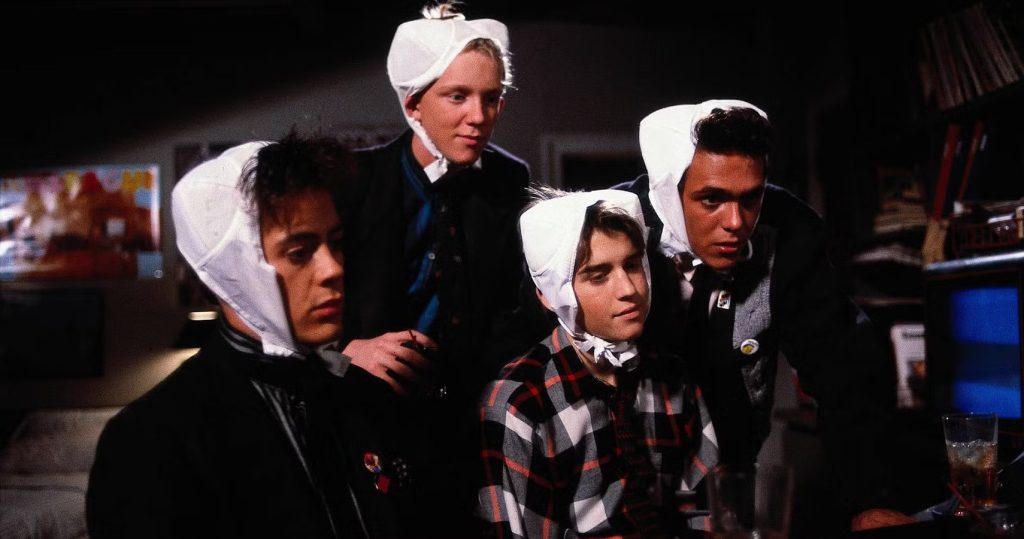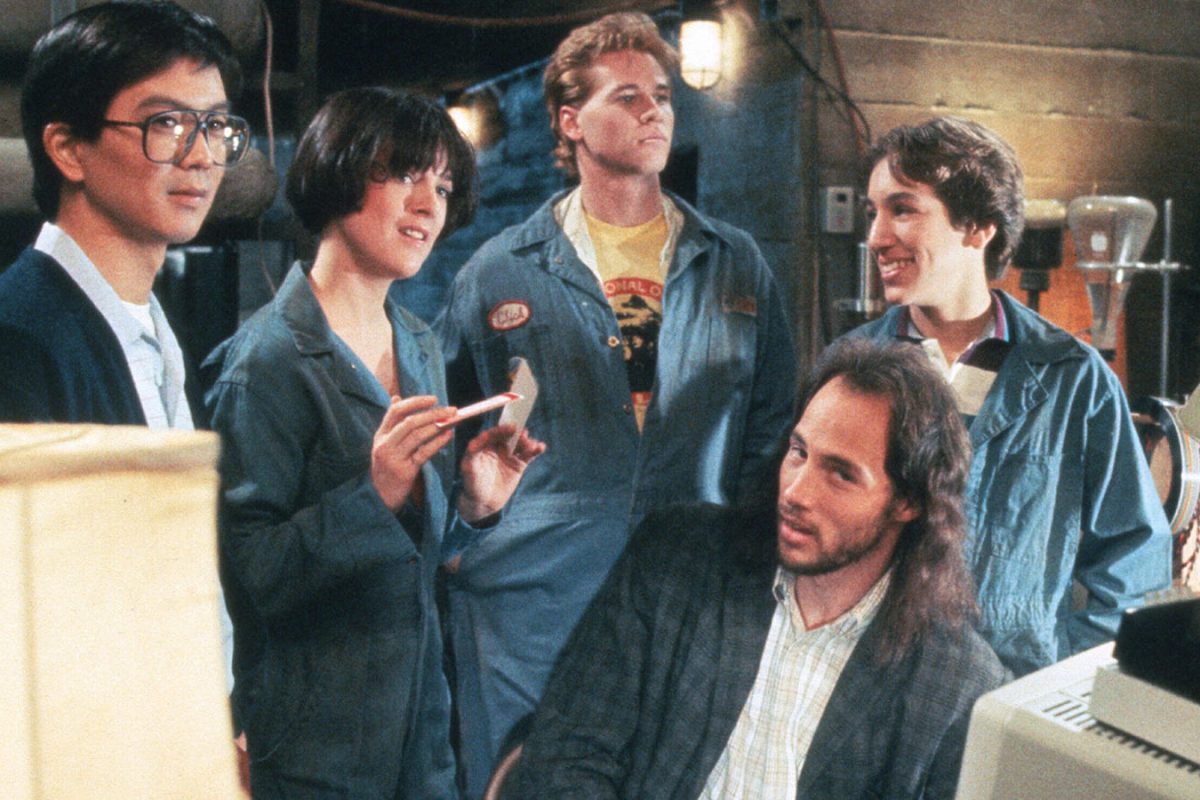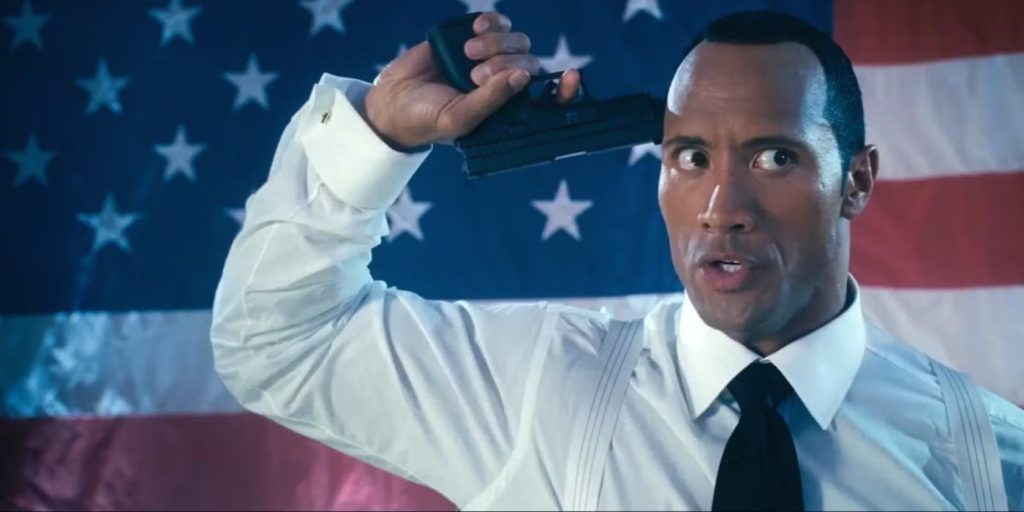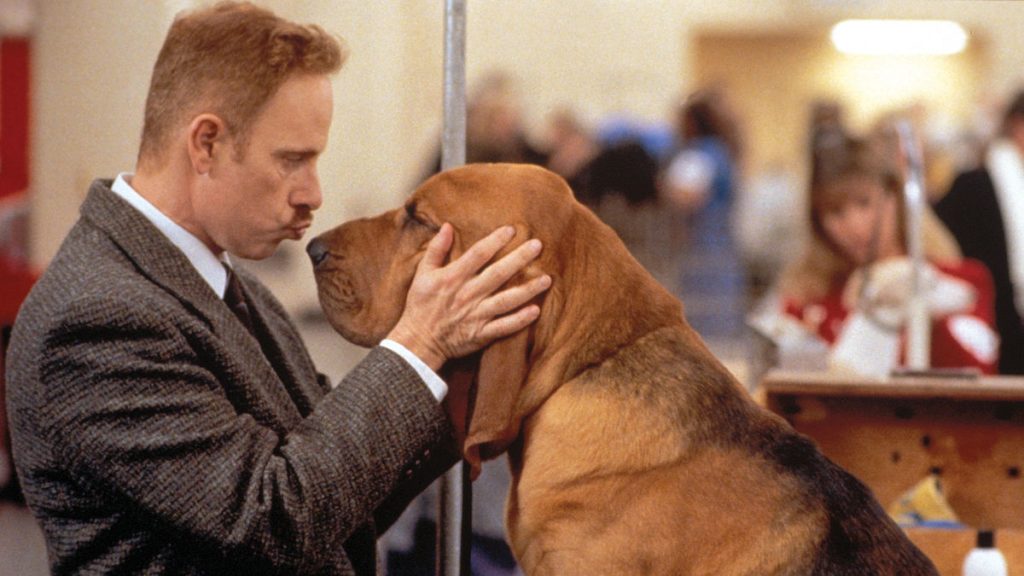By the summer of 1985, the American teen comedy craze was in full swing. The year prior had seen the directorial debut of John Hughes, the filmmaker most synonymous with it, as well as the release of one of its biggest and most enduringly popular titles, Revenge of the Nerds.
That film proved especially important to the genre’s development, because while the archetype of the nerd had always been a key figure, they became increasingly central post-Revenge. In Hughes’s era-defining sophomore hit The Breakfast Club—which came out in February of ‘85—Anthony Michael Hall’s shy nerd gets left behind to do everyone’s homework while the rest of the newly-bonded found family pair off into couples. Granted, in Hughes and Hall’s previous collaboration, Sixteen Candles, he does get the girl, but under, let’s be generous and say, dicey circumstances.
Revenge of the Nerds changed this dynamic by making the pencil-necks the focus of the story, allowing them to use their intelligence—particularly in the fields of science, technology, engineering, and math—to best their jock tormentors and win the affections of the fairer sex (although like Sixteen Candles, Revenge has its ostensibly lovable geeks indulge in some casual sexual assault).
Revenge of the Nerds was a big hit, raking in over $60 million off a budget one-tenth of that, but it was absolutely dwarfed by the blockbuster success of next year’s Back to the Future (released the first weekend of July, 1985). Not that anyone needs a refresher course on one of the most popular movies of all time, but that film saw Michael J. Fox’s teenage everyman and his mad scientist best friend travel 30 years into the past to help his hopelessly dweeby dad score with his mom. (Another tech heavy sci-if adventure film about youngsters, Explorers, came out the following weekend, although that’s more of a young adult, as opposed to teen, film.)
One month after Back to the Future hit theaters, audiences were treated to back-to-back teen comedies that similarly focused on beleaguered eggheads and blended teenage comedy with science fiction: Real Genius and Weird Science.
Directed by Martha Coolidge, fresh off her hit of the previous year, Valley Girl, Real Genius stars Gabe Garrett as Mitch Taylor, a 15-year-old science wiz who earns early admittance into America’s top tech school and comes under the tutelage of Val Kilmer’s Chris Knight, a brilliant and rapscallious graduating senior deadset on avoiding responsibility at all costs.
Unlike Revenge of the Nerds, Real Genius is less a slobs vs. snobs teen sex comedy than it is good vs. evil teen STEM comedy, with the main plot revolving around Mitch and Chris unwittingly building a lethal space weapon at the behest of the sinister CIA (William Atherton, everyone’s favorite ‘80’s dickhead, plays their conniving middle-man professor).
Coolidge was clearly invested in the story, as she had the script retooled after months researching CIA operations, scientific theories about laser beams, and dormitory life at CalTech. Thus, the world of Real Genius feels truer to life than most other films of its ilk, even as it indulges in wacky visual gags involving giant laser blasts and several tons of exploding popcorn. And while the narrative never rises above its basic framework, it takes its characters’ morality into account in a way others of the time rarely do, turning much of the third act into a race against the clock to destroy their grand invention. The song that plays over the end credits, Tears for Fears’s “Everybody Wants to Rule the World,” takes on a doubly ironic, anti-authority flavor.
Real Genius wasn’t a flop; it turned a small profit off its $8 million budget but had the rotten luck of coming out in the shadow of Back to the Future – which held firm as the number one movie at the box office for the majority of that summer – and only a few days (it opened on a Wednesday for some reason) ahead of John Hughes’s highly-anticipated new picture.

In Weird Science, Hughes finally gave the lead role to Hall, although really the film is a three-hander between him, Ilan Mitchell-Smith, and Kelly LeBrock. Loosely adapted from a Pre-Codes comic by Al Feldstein, the plot sees Hall and Mitchell-Smith’s hopelessly horny nerds use their computer skills to create their dream woman, a la Frankenstein.
Unlike Real Genius, it’s obvious Hughes didn’t do any research into the science at the heart of his film, which really operates in the realm of fantasy. LeBrock’s gorgeous dream woman Lisa is pretty much an all-powerful genie, able to change matter at a whim. By the end of the film, both teen hijinks and science have gone out the window, as our nerdy heroes are warding off post-apocalyptic mutants (including The Road Warriors’ Vernon Wells, who unofficially reprises his villainous role from that film), magically appearing nuclear warheads, and talking globs of shit. (When it comes to the human antagonists, Weird Science’s casting director Jackie Burch deserves kudos, as it treats us to early, memorable turns from Bill Paxton and Robert Downey Jr.)
Ultimately, Hughes isn’t interested in his wiz kids having to deal with any moral reckoning over their creation gone awry—the film is devoid of any real dramatic beats—with the sole focus of LeBrock’s synthetic (maybe?) sexpot angel getting them girlfriends their own age.
Still, for an obvious sex comedy, Weird Science is surprisingly chaste. There is one quick bit of full frontal nudity featuring an extra, but for as much as the camera slobbers over LeBrook, she stays clothed for the entire thing. She offers herself up to the boys several times, but neither takes her up on it. Hughes’s movies are rife with material (including and especially Hall’s impersonation of a Black bluesman here, which is equal parts cringey and hilarious) that would offend modern youngster’s (as well as Millenials) sensibilities, but compared to other teen comedies of its day, such as the Porky’s films, it’s not that politically incorrect. Real Genius, for its part, doesn’t include anything more racy than a couple of jokes about big boobs and a hard-on.
Coming so close on the heels of Back to the Future, these two STEM-centric teen comedies would herald a sea change in the genre, but not necessarily an immediate one. (A third teen comedy that would arrive that same month, the absurdist John Cusack vehicle Better Off Dead, features a side-plot involving a horny boy genius, and shares a similar suburban rock launch gag and Frankenstein reference with Weird Science).
The major titles within the genre to come out during the second half of the decade—not counting the Revenge of the Nerds and Back to the Future sequels—generally focused on more traditionally cool and/or romantic characters (Hughes’s Pretty in Pink and Ferris Bueller’s Day Off from ‘86, the Cusack-starring Say Anything from ‘89), with the teen comedies of the ‘90s mostly following this lead.
But by the Aughts, the pendulum had swung back hard. It would be easy to point to these ‘80s titles as playing a major part in that shift, although the later versions of this (most notably and obviously the smash television sitcom, The Big Bang Theory, which follows a group of adolescent nerds who just happen to be in their 30s) are more defined by their obsession with nerdy culture — comic books and superhero movies, Star Wars and Star Trek, video games and Dungeons & Dragons, etc—than the STEM-centric pursuits of their ‘80s counterparts, which were clearly a reaction to the ratcheting nuclear paranoia of the tail end of the Cold War.
Unlike proper science fiction films, none of these movies are that prescient. You can be generous and say that Real Genius and Weird Science are dealing with proto-versions of current tech, like drone warfare and AI, but it’s all so theoretical as to not make for any real interest. We’re still a long way off from having killer space lasers (despite what Marjorie Taylor Greene would have you believe) and fully-sentient sexbots.
More fantastical though is the optimistic idea posited by these films that all of this science can be used for good, that the STEM kids would actually consider the ethical implications of their inventions, and would ultimately use their brains to make the right moral decisions. Talk about science-fiction.



